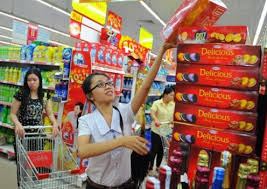|
Producers battle to
put products on supermarket shelves
In order to
obtain the room at supermarkets to display products, manufacturers have to
follow complicated procedures and pay different kinds of fees.
The big power of supermarkets
The director of a fast moving
consumer goods brand said in order to be able to put products on the
supermarkets’ shelves, enterprises have to follow very complicated
procedures.

“At first, you need to send email to
supermarkets to introduce your company and your products. And you need to be
patient enough to wait for the replies,” he said.
In general, according to the
director, it takes several months to follow all the procedures, while it
takes at least one year to obtain the goods registration certificate. Food
and imports manufacturers and suppliers have to show the certificates on the
products’ quality granted by the Ministry of Health, the customs declaration
documents and the goods origin certificates.
“Even when supermarkets agree to
grant codes to your products, this does not mean that the products would be
put on the supermarkets’ shelves,” he said.
“The products would be displayed
somewhere, and they would be on the shelves when the supermarkets find them
salable,” he explained.
The best positions at supermarkets
have always been occupied by foreign invested enterprises or joint ventures,
which have bigger budgets for advertisements, and products more salable.
According to Lam Huong, Director of
Hoang Huong Company, supermarkets have “big power and relations.” The
products with supermarkets’ private brands are put in the positions which
easily catch the consumers’ eyes. Meanwhile, domestic enterprises’ products
are displayed in the positions hidden from view.
Previously, SG Food’s products were
put in disadvantageous positions. However, since the day it accepted to make
products for supermarkets, the company’s products have been put in
advantageous positions.
In many cases, the “life expectancy”
of the products at supermarkets is very short--about three months, and then
they are removed from the supermarkets’ shelves. It is because too many
enterprises queue up to enter supermarkets, while the display area at
supermarkets is limited.
Therefore, supermarkets usually carry
out the “purge campaigns,” removing from the shelves the products with low
sales or the products of the companies which rarely organize sale promotion
programs.
The representative of a food
manufacturing enterprise complained that the enterprise’s products could
exist at a supermarket for four months, even though the sales were relatively
good and the products have big potentials.
“I have heard that the supermarkets
compared the sales of the products and they only retain the products which
have the best sales, while they don’t care about the potentials,” he said.
Ngo Trung Quan, Director of Dai Viet
Huong Company, said it is understandable why supermarkets have to exclude
products from their distribution chains.
“The display area is limited, while
the volume of goods is too big,” he said. Big brands don’t have to pay fees
to get the room at supermarkets, because retailers would be willing to
display the products to ensure their turnover.
Analysts said if the State wants
supermarkets to display diversified products so as to ensure the benefits of
the whole society, it needs to issue legal documents on the issue.
Phuoc Linh,
|
Chủ Nhật, 6 tháng 10, 2013
Đăng ký:
Đăng Nhận xét (Atom)
Không có nhận xét nào:
Đăng nhận xét